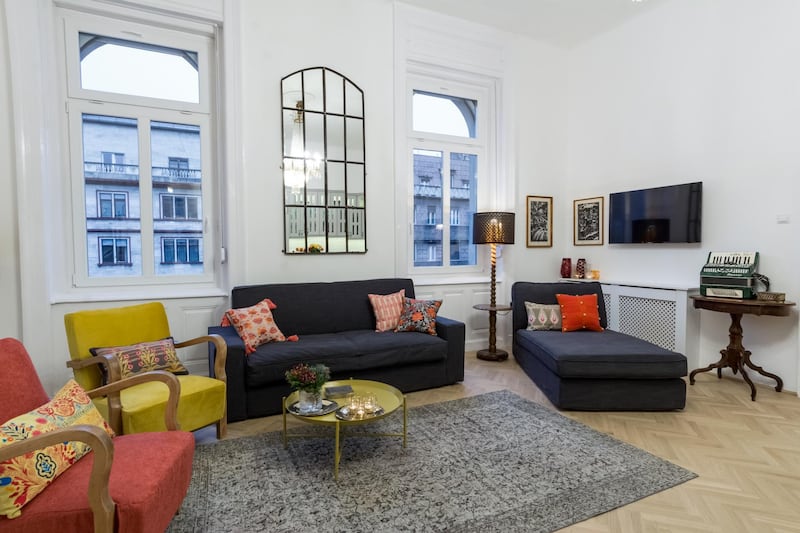Tasked with furnishing a late 19th-century penthouse apartment in historic Budapest, a city I had not previously visited, presented a unique set of challenges. Not least of which was that I had to achieve my buying mission within just 10 days, in two separate trips to Hungary, over the course of one month.
The apartment was still a construction site, but nearing the end of a six-month renovation when I first visited at the end of November, and even then its grand proportions were already evident. Standout features included four-metre-high ceilings, new wooden parquet floors and locally handmade floor tiles, tall double doors with original brass fittings separating the bedrooms from the hallway, and a truly magnificent crystal chandelier.
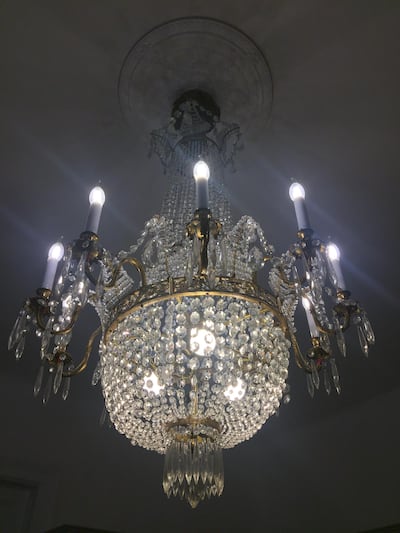
Since its construction, the building has borne witness to the evolution of art nouveau, the development of art deco, grand soirées, two world wars, Nazi occupation, communist rule and the subsequent ending of the Cold War in the early 1990s. When its new owner, who is Irish and a long-term resident of Dubai, purchased the four-bedroom property earlier this year for about €160,000 (Dh693,000), it required an extensive renovation to make it habitable according to 21st-century standards.
His motivation to buy the apartment stemmed from a number of enjoyable winter holidays in the city, and he identified an opportunity to let the property as a premium Airbnb investment, as well as it acting as an occasional mid-European base for personal use. The property is located within walking distance of many of the city's galleries, museums and theatres.
The resulting design brief was to create something that was contemporary, comfortable and hard-wearing, but also paid homage to the heritage of the building and communicated the essence of its location. Having seen how I'd furnished my Dubai apartment with vintage and second-hand finds, the owner, who is a friend, enlisted my help, as he thought we had a similar style and design ethos, not to mention a budget-conscious approach. He knew he "didn't need to spend loads of money for it to be amazing", he said. He was right, since the building itself would largely lead the way.
Our strategy was to use the city's four large Ikea stores for anchor items, such as beds, wardrobes and sofas, without creating an identifiable cookie-cutter Ikea look, and then blend these with pieces found in flea markets, charity shops and vintage stores. As we learnt, Google is the friend in need for rooting out such places, and bargaining is a key skill in any such endeavour.
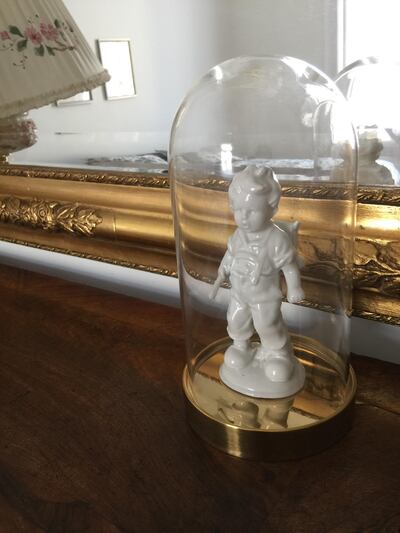
Whenever he travelled, my father used little cards (this was in the pre-digital era) to write out lists of foreign currency values in multiples of 10 against our home currency. Given that English is not widely spoken in Budapest outside of the hospitality industry, this little trick proved invaluable in negotiations and was quicker than firing up my phone each time. They'd point, I'd point, I'd walk away, they (might) follow, I (might) go back… and a mutually agreeable price might eventually be settled upon. In the process, I discovered that if I put my thumb over the larger figures, it discouraged excess.
I spent a day and a half with “the client” in Budapest to ensure that my design thinking would reflect his vision. Our first port of call was Artkraft, a used- and upcycled-furniture warehouse in an old industrial area. Here, we sourced a large, reclaimed metal window frame fitted with mirrored glass, along with a roughly worked steel table. Both were cool, industrial-inspired elements that would start to give the heritage space a more modern edge. As a plus, since the mirror would hang between the windows in the living room, it would reflect the striking form of the chandelier, which was purchased from the previous owners and had originally been installed by their grandmother.
Next, we went to the outskirts of the city, to Budapest's largest flea market, Ecseri Piac, where you can find everything from antique furniture and Soviet-era relics to kitsch collectibles and curios. In two shops, we sourced three bronze empire lights, for the hallway and master bedrooms, as well as two vintage glass pendant lamps, all for under Dh3,500 – a fraction of what the city's antique shops would be asking. Clearly, it's impossible to be too prescriptive when in acquisition mode. It's about feeding in pieces that have the potential to blend into a notional mood board and layering on to that. Photographs are key to keeping track, as none of the pieces would be in situ until much later.
I opted for white open wardrobe frames from Ikea – more aesthetically pleasing than the look of cheap, self-assembly Formica laminate – and also purchased a new sofa bed and a modern chaise longue in graphite grey from the same shop. Pops of strong accent colour were added to the living room with two art deco chairs bought from Ecseri for just Dh65 each. The chairs were sound, but the upholstery needed attention. The additional colours were a fortuitous selection, made from an otherwise entirely bland and dated sample book at the workshop (they were, in fact, the only fabrics held in stock that didn’t evoke the style of a grandmother’s 1980s sitting room).
Cushions were brought from Khaadi online in Pakistan (UAE branches don't currently stock homeware), as its current range coincidentally reflected the burnt orange, mustard and graphite palette already evident in the apartment's soft furnishings. Local rug supplies were uninspiring, but Abu Dhabi-based online furniture supplier Ebarza had a refurbished vintage rug in a soft olive grey, which would be both practical and hard-wearing. Unfortunately, the company doesn't deliver to Hungary. For the statistically minded, the brand's 2.5m by 1.5m hand-finished rugs weigh 11 kilograms, and will fit into a large suitcase, making them exempt from local customs duty, payable if otherwise sent by courier. This still leaves room for a generous 19kg of winter-weather wardrobe packing when flying direct from Dubai with Emirates.
Furniture almost done, the next challenge was to find the items that make a house a home – artwork and accents. Hungary is known for its fine-cut glass and coloured crystal, and also has a strong cultural tradition of handworked embroidery on cushions, tablecloths and napkins. Best of all, vintage pieces can be picked up for Dh20 to Dh50.
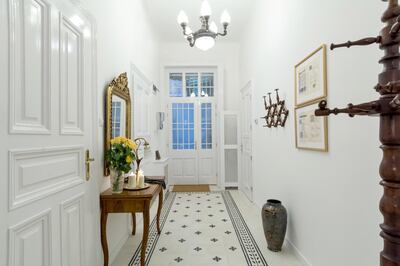
One of my favourite Budapest stores was a charity shop called Csarnok Bizi, located in Budapest IX, Csarnok tér 5, where the disgorged contents of grand Hungarian display cabinets come to find new homes. Porcelain, embroidery, pottery, glassware, lamps and pictures were all bought here from wonderful Hungarian ladies, who didn’t let the lack of a common language get in the way of multiple sales.
Yet, displaying these pieces as their original makers had done would not have provided the modern edge we were seeking. Instead, cushion covers became artworks with the addition of new picture frames from Ikea, coloured glass was displayed in diversely themed groups with the addition of tea lights, and strong handmade pottery provided sculptural accents of contrasting colour on radiator shelves. All entirely unique and all low in cost, these were a creative alternative to the ubiquitous mass-produced accents found in homeware stores.
There are more than 40 pictures hanging in the apartment, and almost all were assembled, reassembled or newly created in some way. To a certain extent, all tell a story, educate a little, and interpret the culture and the heritage of the city in a new way.
An old book of poems, the translated works in Hungarian of the great European poets and writers, along with sepia plates of classical artwork hanging in Budapest’s museums and galleries, was picked up at the market for under Dh30, and broken up and mounted in a variety of grouped Ikea frames. These were block-themed in gold, black, silver and white, in a variety of sizes.
They also give each of the bedrooms a notional identity: gold frames and classical images for a grand 19th-century salon; silver grey for early 20th-century nouveau; mid 20th-century with black and white postcards and artwork; and local folk arts and crafts reworked for a cosy, yet edgy, 21st-century look.
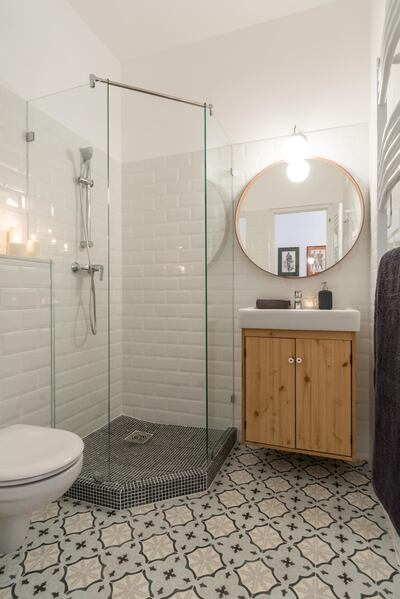
Ten days in hunter-gatherer mode on the streets of Budapest and the mission is, astonishingly, accomplished. And a new apartment listing on Airbnb sums up the resulting interior: “Chic and contemporary grandeur at the heart of historic Budapest.”
_______________
Read more
[ How to cash in and travel with Airbnb in the UAE ]
[ Purple set to reign as Pantone announces colour of the year ]
[ Designers share festive home decor tips on how to create the perfect holiday atmosphere ]
_______________
